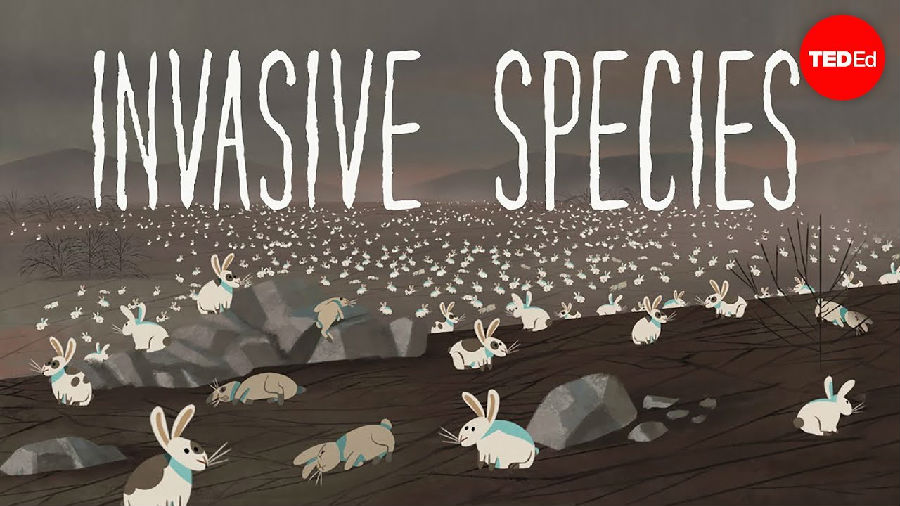(单词翻译:单击)
Massive vines that blanket the southern United States,
覆盖美国南部的巨大藤蔓,
climbing as high as 100 feet as they uproot trees and swallow buildings.
爬上近百英尺高,并将树木连根拔起,吞没房屋。
A ravenous snake that is capable of devouring an alligator.
贪食的蛇可以吞掉鳄鱼。
Rabbit populations that eat themselves into starvation.
兔群能将周围的食物吃光。
These aren't horror movie concepts.
这不是恐怖电影的情节。
They're real stories, but how could such situations exist in nature?
这是真实的故事,但是这类的情况是如何存在于自然界的呢?
All three are examples of invasive species, organisms harmful not because of what they are, but where they happen to be.
接下来举三个物种入侵的实例,生物的有害性并不在取决于它们是什么,而取决于它们在哪。
The kudzu vine, for example, had grown quality in its native east Asia, eaten by various insects and dying off during the cold winters.
比如葛藤,在它的故乡原产地东亚会被各种昆虫食用,而且在寒冬枯萎。
But its fortunes changed when it was imported into the southeastern United States for porch decoration and cattle feed.
但是当它成为门廊装饰和家畜饲料并被出口到美国东南部时,它时来运转了。
Its planting was even subsidized by the government to fight soil erosion.
政府为了对抗水土流失甚至鼓励人们种植葛藤。
With sunny fields, a mild climate, and no natural predators in its new home,
由于阳光充足、气候温而且在它的新家没有天敌,
the vine grew uncontrollably until it became known as the plant that ate the South.
葛藤的长势失去控制,直到它被称为“吞食南方的植物”。
Meanwhile in Florida's Everglades, Burmese pythons, thought to have been released by pet owners,
与此类似,佛罗里达州的大沼泽地,作为宠物的缅甸巨蟒,由于被其主人释放到野外,
are the cause of decreasing populations of organisms.
导致了该地生物数量的减少。
They're successfully outcompeting top predators, such as the alligator and panther,
它们成功地战胜了其他顶级捕食者,比如鳄鱼和黑豹,
causing a significant reduction in their food sources.
导致了它们食物资源的减少。
They're not a problem in their native Asia because diseases, parasites, and predators help to control their population size.
它们原产地亚洲并不存在这种问题,因为疾病、寄生虫和天敌控制了它们的种群规模。
And in Australia, European rabbits eat so many plants that they wipe out the food supply for themselves and other herbivores.
在澳大利亚,欧洲野兔食用了大量的植物,它们吃光了自己和其他本地动物的食物。
They're a pretty recent addition, intentionally introduced to the continent because one man enjoyed hunting them.
它们在最近才开始增加,而它们被人引入这块大陆只是因有一个人喜欢猎杀它们。
Like the Burmese pythons, various factors in their native habitat keep their numbers in control.
像缅甸蟒,原产地的多种因素制约了它们的数量。
But in Australia, the lack of predators and a climate perfect for year-long reproduction allows their populations to skyrocket.
但是在澳大利亚,天敌的缺失和适宜全年繁殖的气候,使得它们的数量飞涨。

So why does this keep happening?
那么,为什么这样的事情经常发生呢?
Most of the world's ecosystems are the result of millennia of coevolution by organisms,
世界上的大多数生态系统是由生物经过上千年的共同进化,
adapting to their environment and each other until a stable balance is reached.
不断的适应彼此和周围环境,最终形成的一个稳定的平衡。
Healthy ecosystems maintain this balance via limiting factors,
健康的生态系统通过限制因素维持这一平衡,
environmental conditions that restrict the size or range of a species.
环境条件限制了物种的大小和范围。
These include things like natural geography and climate, food availability, and the presence or absence of predators.
这些条件包括了自然地理、气候、食物供应以及是否存在天敌。
For example, plant growth depends on levels of sunlight and soil nutrients.
比如,植物的生长依赖于阳光和土壤营养程度。
The amount of edible plants affects the population of herbivores, which in turn impacts the carnivores that feed on them.
可食用植物的规模影响食草动物数量,这又影响到以它们为食的食肉动物。
And a healthy predator population keeps the herbivores from becoming too numerous and devouring all the plants.
一个正常的捕食者数量能够避免食草动物不会过多而吃光所有植物。
But even minor changes in one factor can upset this balance,
但是,即便某个因素上一个微小的改变都能破坏这一平衡,
and the sudden introduction of non-native organisms can be a pretty major change.
并且,突然引进的非本地物种可是一个相当大的改变。
A species that is evolved in a separate habitat will be susceptible to different limiting factors,
一个在相对隔绝的栖息地进化的物种,对不同的限制因素,
different predators, different energy sources, and different climates.
不同的捕食者,不同的能量来源以及不同的气候都是比较敏感的。
If the new habitat's limiting factors fail to restrict the species growth,
如果新栖息地的限制因素不能够限制住物种数量,
it will continue to multiply, out-competing native organisms for resources and disrupting the entire ecosystem.
那么它将持续增长,与本土生物竞争资源,并且扰乱整个生态系统。
Species are sometimes introduced into new habitats through natural factors, like storms, ocean currents, or climate shifts.
物种偶尔会由于自然因素而将物种引入新栖息地,比如,风暴,洋流或者气候变迁。
The majority of invasive species, though, are introduced by humans.
大部分入侵物种由人类引入,通常这是无意间发生的。
Often this happens unintentionally, as when the zebra mussel was accidentally brought to Lake Erie by cargo ships.
就像斑马贻贝被货船意外地带进伊利湖一样。
But as people migrate around the world,
但是由于人们在世界范围内迁移,
we have also deliberately brought our plants and animals along, rarely considering the consequences.
我们通常特意的带上我们的植物或动物一起,极少考虑后果。
But now that we're learning more about the effects of invasive species on ecosystems,
但是现在,我们知道了更多生物入侵对生态环境的影响,
many governments closely monitor the transport of plants and animals, and ban the imports of certain organisms.
许多政府对动植物运输严密监管,并且禁止某些物种入境。
But could the species with the most drastic environmental impact be a group of primates who emerged from Africa to cover most of the world?
但是,是否当初一群某种灵长类动物,由强烈的环境变化从非洲出发而几乎占领全球呢?
Are we an invasive species?
我们人类到底是不是入侵物种呢?


